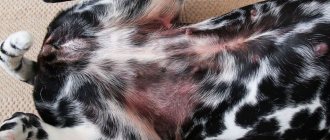5 / 5 ( 1 voice )
Infectious diseases are terrible not only for animals, but also for humans. Leptospirosis in dogs is one of the most dangerous diseases (more than half of infections are fatal). Every pet owner should know the symptoms and preventive measures of leptospirosis so that the infection does not become fatal for the pet.
Description of the disease
Leptospirosis or infectious jaundice, or Weil's disease, is an infectious disease caused by the bacterium Leptospira. Distributed almost throughout the world (except Antarctica), affecting most species of mammals. More than 200 species and subspecies of the pathogenic bacterium Leptospira (called serotypes or serogroups) are known to veterinary medicine. But more than 50% of them do not cause pathologies.
Important! Leptospira bacteria are close “relatives” of borreliosis and syphilis.
The infection is resistant to low temperatures and can remain viable and virulent for many months. Even if the ambient temperature drops to -70 degrees. An increase in ambient temperature combined with an increased level of humidity is a favorable environment for maintaining life activity for up to a year and a half. Most often found in stagnant bodies of water, with a large accumulation of Leptospira bacteria, a visible film can form on the surface of the water.
In water it can remain active for 30 days, under favorable conditions. In running water no more than 10 days. In soil with high humidity, Leptospires remain virulent for up to 300 days.
Bacteria are susceptible to drying out and changes in pH. When the temperature rises to 76 degrees and above, the infection dies instantly.
Routes of infection
The main routes of infection with leptospirosis:
- Contact. Infection occurs through contact of mucous membranes or damaged skin with contaminated soil, water, sick animals or their secretions.
- Nutritional. Infection occurs by the bacteria entering the stomach - quenching thirst from infected bodies of water, eating raw meat of leptospirosis carriers or contaminated (infected animals) products.
Important! Dogs can shed Leptospira in their urine without showing clinical signs.
Carriers of leptospirosis are most often rodents and small predators that eat them:
- Rats;
- Hedgehogs;
- Shrews;
- The bats;
- Voles;
- Nutria;
- Ferrets;
- Martens;
- Arctic foxes;
- Foxes.
This is not the entire list of potential carriers of leptospirosis. Almost all mammals are susceptible to the disease, including cattle, artiodactyls, and almost all canines. Remarkably, cats are the least likely to get sick.
What is leptospirosis, its forms in dogs
Leptospirosis is an infectious, natural focal disease of animals and humans, which ranks first among zoonoses in terms of distribution. The disease is caused by a motile bacterium of the genus Leptospira. In total, more than 200 serotypes are known, some of which do not pose a threat to animals.
Features of the pathogen:
- After entering the pet’s body, the bacteria is carried through the bloodstream to various organs, where it begins to actively multiply. Then, after a few days, some of the pathogenic microorganisms re-enter the blood. The dog's immune system destroys the leptospira, but this process releases endotoxin, which destroys blood cells (red blood cells).
- The bacterium lives in the external environment. It can survive in moist soil for up to six months; in stagnant waters (ponds, lakes) it persists for several months.
- Leptospira are very sensitive to drying, pH changes and elevated temperatures (at 79-96°C they die almost instantly).
- At -70°C, frozen organs remain viable and virulent for several months.
- Anthropozoonosis is widespread throughout the world.
Leptospirosis is a multisystem disease. Most often it affects the liver and kidneys, as well as the lungs, spleen, vascular walls, anterior chamber of the eye, retina, skeletal and cardiac muscles, meninges, pancreas and genitals. Suppresses the blood coagulation system.
Variants of the course of infection in dogs:
- Spicy. Symptoms of the disease develop rapidly, and the animal’s condition deteriorates sharply. This form in many cases ends in death, since all organs and tissues are affected. It can manifest itself as an icteric and hemorrhagic type of leptospirosis.
- Chronic (latent). The symptoms are not clearly expressed, the dog periodically becomes lethargic, digestive disorders and loss of appetite are observed.
- Complications are accompanied by severe pathologies of the gastrointestinal tract, urinary and cardiac systems, and autoimmune processes.
Symptoms and signs in dogs
The disease has a huge number of clinical signs, as it affects almost all internal organs, nervous and circulatory systems, and skeletal muscles . American doctors have nicknamed leptospirosis the chameleon disease, because due to the number of symptoms, leptospirosis can be confused with canine distemper or infectious hepatitis.
Main symptoms and signs of leptospirosis:
- Apathetic state, inactivity;
- Refusal to eat;
- Redness or yellowing of mucous membranes;
- Vomit;
- Diarrhea, other signs of gastrointestinal disorders;
- Blood in the urine, dark urine;
- Poor urination, decreased amount of urine;
- Stomatitis;
- Increased body temperature;
- Deterioration of blood clotting;
- Lameness, loss of coordination;
- Shortness of breath, rapid pulse;
- Wheezing when breathing;
- Yellowness of the epithelium and mucous membranes;
- Dehydration;
- Abdominal pain;
- Anorexia.
Most often, symptoms appear 4–9 days after infection. Signs of leptospirosis may vary depending on which organs are affected. All organs may be affected, in which case the symptoms will be extensive. But the greatest danger this disease poses is that the symptoms are not always pronounced; it all depends on the individual characteristics of the body.
After entering the body, the easiest way for Leptospira bacteria to penetrate is the kidneys; therefore, the first clinical signs are associated with urination. Then the functioning of the liver, gastrointestinal tract, and spleen is disrupted. Also, the walls of blood vessels are destroyed, the functioning of the circulatory system is disrupted, which leads to internal bleeding.
Important! Animals that have recovered from the disease remain carriers of Leptospira for a long time.
Forms of leptospirosis
Leptospirosis in dogs is divided into 3 forms - chronic, hemorrhagic and icteric. The symptoms depend on the form of the disease. The state of the dog’s immune system determines the nature of the disease.
Chronic
The disease enters the chronic phase if the dog has managed to get sick from other types of leptospirosis. The chronic form lasts several years, and with a decrease in immunity or concomitant diseases it reappears. Diagnosed quite rarely.
Symptoms of chronic leptospirosis:
- Anorexia, loss of weight and appetite;
- Pallor of mucous membranes;
- Enlarged lymph nodes;
- Epithelial necrosis;
- Hard breath;
- Apathetic state;
- Cardiopalmus;
- Lack of estrus in females and sexual desire in males;
- Stillbirth (loss of fetuses in females).
Hemorrhagic
The anicteric phase of leptospirosis occurs most often in fully formed individuals. The duration of the acute hemorrhagic phase is up to 7 days . If treatment is untimely or incorrect, death occurs in 70% of cases, or the disease progresses to the chronic stage.
The Leptospira bacterium in the hemorrhagic form of the disease primarily affects the circulatory system. Based on this, the clinical signs are:
- A sharp increase in body temperature to 41 degrees or more;
- Increased thirst;
- “Marbled” mucous membranes (bright red pigment of the mucous membranes interspersed with pale pink and white);
- Refusal to eat;
- Lethargy, inactivity;
- Diarrhea;
- Vomit;
- Dehydration;
- Cramps.
After 3–4 days, the body temperature drops to normal or lower. Blood impurities are clearly visible in the vomit and stool. Within 2–3 days, with a probability of more than 80%, the dog can no longer be saved. The animal will die from dehydration or internal bleeding.
Jaundice
A form of leptospirosis, called icteric, is diagnosed more often in dogs with immature immunity, under the age of two years. The acute course of the icteric phase lasts up to 7 days , the mortality rate is about 65%.
The symptoms are similar to hemorrhagic . The main difference between the two phases is the pigmentation of the mucous membranes; during the icteric phase, the mucous membranes of the mouth, eyes and the upper layer of the epithelium become yellow. This is due to the fact that the Leptospira bacterium is localized in the liver. Leads to increased levels of bilirubin in the blood, which in turn gives a yellow tint.
Death occurs from intoxication of the body.
Diagnostic methods
The main carrier of Leptospira is blood, or rather the antibodies produced by the body against the bacterium. Antibodies can be detected as early as 10 days after infection. Leptospira can then be detected in urine. Therefore, blood and urine collection are an exceptional condition for the correct diagnosis of leptospirosis.
Important! Blood and urine tests provide a more plausible picture before introducing antibiotics into a dog's body, regardless of the duration of symptoms.
Test for leptospirosis in dogs
The microagglutination test, a serological blood test, is the most widely used diagnostic test for leptospirosis. But it must be carried out in conjunction with urine tests, and the procedure must be repeated after 2–3 days . Since in the initial stages the number of antibodies to Leptospira may be “within normal limits” (1:100 and even 1:200 is considered normal in regions that do not have outbreaks of epidemics). Also, the results are highly dependent on the quality control of the laboratory.
General data and routes of infection
Leptospirosis is an infectious disease of a bacterial nature, which is clinically manifested by intoxication syndrome, hemorrhagic manifestations, and damage to the kidneys and liver.
The causative agent of leptospirosis in dogs is the spirochete Leptospira interrogans. The bacterium is a spiral-shaped movable thread. In dogs, the disease can be caused by several serotypes: L. Icterohaemorrhagiae, L. Grippotyphosa. The bacterium does not tolerate exposure to low temperatures and thrives in warm and humid environments. This factor is associated with the fact that outbreaks of leptospirosis occur in the summer and spring, and in winter the disease practically does not occur.
The main mechanism of infection transmission is contact. It can be implemented in the following ways:
- swimming in open water;
- through consumption of raw water, contaminated milk or meat;
- upon contact with an infected animal.
Most often, dogs become infected when swimming in contaminated bodies of water. In this case, infection does not occur through the skin; the bacterium can enter the body only through abrasions or wounds (when water comes into contact with the animal’s blood).
Treatment
Treating leptospirosis at home, self-diagnosis and self-medication is prohibited! Treatment is prescribed only by a qualified veterinarian and only after laboratory tests. In this case, the likelihood of positive dynamics during therapy increases.
Treatment requires comprehensive treatment, aimed primarily at destroying the Leptospira bacterium itself. It is also necessary to restore the body, remove intoxication and normalize the functioning of the affected internal organs.
In addition to drug treatment, the dog must be prescribed a diet. Food should only be of high quality, low in fat and protein. Drinking plenty of fluids and eating small meals is prescribed.
List of drugs
| Intramuscularly | ||
| Name | Price | Application |
| Hyperimmune serum against leptospirosis | 424 rubles | 0.5 ml per 1 kg of body weight; 1 time per day 2 – 3 days |
| Streptomycin | 21 ruble | 10-15 units/kg 2 times a day for a course of 5 days. |
| Hemodez | 45 rubles | 10 ml/kg once or twice a day |
| Oral | ||
| Name | Price | Application |
| Lycopid | 250 rubles | 0.5 mg per 3 kg of body weight once a day for 10 days. |
| Thiotriazolin | 525 rubles | up to 10 kg – ½ table. 2 times a day, up to 20 kg – 1 tablet. 2 times a day, more than 20 kg – 1 tablet. 3 times a day |
| Cordiamine | 70 rubles | Up to 3 drops on the root of the tongue |
| Enterosgel | 400 rubles | up to 2 tbsp. dissolve the gel in 200 ml of water, pour into the mouth |
| Hepatovet | 620 rubles | 2-3 ml of suspension for every 10 kg of weight. Divided into 2-3 doses |
Treatment options
The treatment strategy is developing in the following directions:
- Elimination of the pathogen. Antibiotics and immunomodulators are prescribed, and the use of hyperimmune serum is indicated on the first day.
- Control vomiting, diarrhea and dehydration: use injectable antiemetic drugs. Rehydration mixtures that have a detoxifying effect are administered intravenously by drip.
- Restoring blood flow and stabilizing cardiac activity. They use Hemobalance, Gamavit, cardioprotectors, and multivitamin preparations.
- Restoring the functional state of the kidneys and liver: hepatoprotectors and detoxicants are used.
- Diet therapy - treatment begins with a starvation diet, which, after vomiting stops, is replaced with a gentle one. Ready-made veterinary food is prescribed for dogs with kidney, liver or heart diseases, depending on which organ is more affected. The duration of use of therapeutic food is determined by a veterinarian.
Possible consequences
Dioxycycline, a broad-spectrum antibiotic, is also used as part of combination therapy. It has established itself as a drug with positive dynamics against gram-negative microorganisms (including Leptospira bacteria). Apply orally 1 time per day, 10 mg per 1 kg of dog weight. The price of the drug is 30 rubles for 10 capsules.
Leptospirosis in dogs is a serious disease, the consequences of which are sometimes irreversible. After long-term treatment, restorative therapy is often prescribed. Which is aimed at avoiding the consequences of the disease. Dogs that have had leptospirosis experience:
- Liver dysfunction;
- Chronic diseases of the kidneys and adrenal glands;
- Disturbances in the gastrointestinal tract;
- Lesions of the visual organs;
- Disorders of the cardiovascular system;
- Inflammatory processes of the respiratory tract;
- Complete or partial paralysis.
Dogs that have recovered from Weill's disease remain carriers of the infection for several years. But those who have suffered the disease themselves develop lasting, lifelong immunity.
Prevention
To avoid infection with infectious jaundice, it is necessary to observe basic hygiene standards. Dogs in crowded conditions (kennels, pet hotels, shelters) are at increased risk. Also pets that often come into contact with cattle. Hunting dogs and others that eat small rodents and quench their thirst in stagnant bodies of water.
Prevention of leptospirosis includes keeping animal areas clean. Exclusion from the diet of small rodents and wild animals (potential carriers of the bacteria). Prohibition on drinking from puddles and other sources of stagnant bodies of water (while walking, carry clean drinking water with you not only for yourself, but also for the dog).
Serums against leptospirosis
Dog vaccination is the main and most effective prevention against leptospirosis. Immunization against viral infections is carried out with a complex serum that includes Leptospira strains.
The most popular vaccines against leptospirosis with average clinic prices:
- Vanguard , 1200 rubles;
- Multikan-6, multikan-8, 800 rubles;
- Nobivak , 1300 rubles;
- Biocan , 1100 rubles.
The first immunization is carried out at the age of approximately 8 weeks, after 21 days a revaccination is required. The next time the serum is administered at one year of age, then duplicated annually until the end of the dog’s life.
A veterinarian in areas unfavorable for leptospirosis may prescribe immunization more often than once a year (once every 6–9 months, depending on epidemic outbreaks). The picture is the same for hunting dogs; the veterinarian may recommend administering the serum more often than other pets.
Is the disease dangerous for humans?
Almost all mammals on the planet suffer from leptospirosis; unfortunately, humans are no exception. Therefore, preventive measures for dogs should be taken more than seriously. After all, this is fraught not only with the death of the pet, but also with a deterioration in the health of the owner.
If clinical signs of leptospirosis are detected in a dog, the owner must carefully observe safety measures. It is best if the animal is placed in a hospital hospital. But if this is not possible, then it is very important:
- Avoid contact of a sick dog with children and other animals;
- During treatment, avoid contact of any kind of dog secretions with human skin and mucous membranes;
- All types of procedures with animals should be carried out with rubber gloves and thick clothing;
- Carry out sanitary treatment of the entire house, and, if possible, daily disinfection of the room in which the sick dog is kept;
- Minimize contact with an infected pet, do not allow licking of the face and hands;
- After each manipulation with an infected dog, be sure to wash your hands with soap and water, above the elbows. Even if gloves were used.
For both dogs and humans, serum against leptospirosis can be administered. Vaccination against infectious jaundice can be given to people starting at the age of seven. For persons who have constant contact with animals, immunization against leptospirosis is recommended by doctors.
Is leptospirosis transmitted from dogs to humans?
Yes, theoretically this is possible. A sick dog excretes bacteria in its urine and may lick its owner after licking its own genitals. Thus, infection is possible if the bacterium gets on the mucous membranes of a person or on a wound. According to our observations, this is very rare; among our many patients, no infection of the owner was noticed (although all of them are informed about the risks and observe hygiene more carefully than before the diagnosis of “canine leptospirosis”).
I will repeat the words that everyone is tired of, but which do not lose their relevance: leptospirosis, like most infections, is much easier to prevent (or reduce the severity of the disease) with the help of standard vaccinations than to treat later. I wish you and your pets not to get sick.











